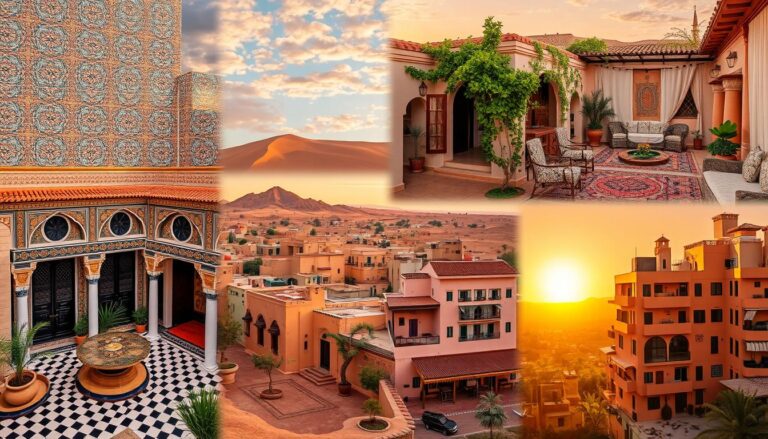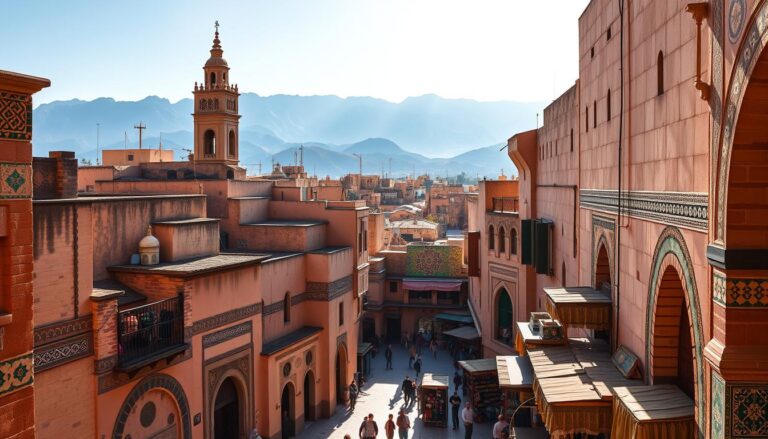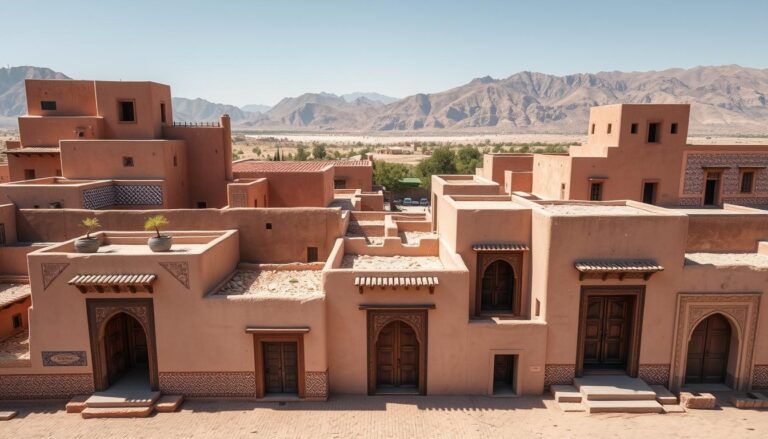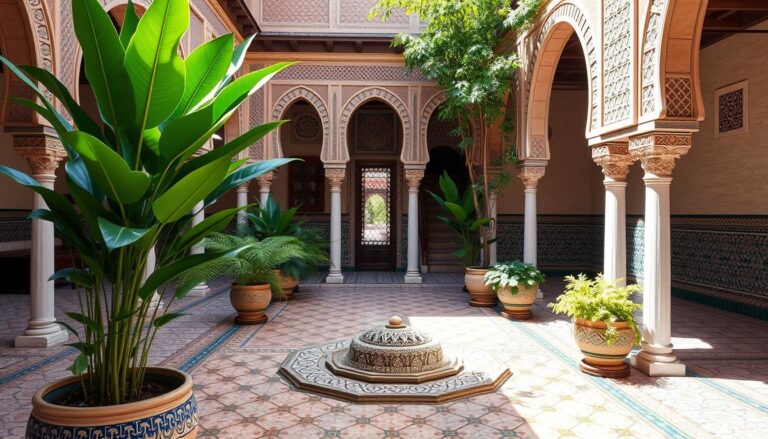Morocco’s hot and dry climate makes it hard to keep homes cool. But, the country’s traditional architecture has found clever ways to beat the heat. Using the environment, Moroccan builders have created natural cooling methods.
They use things like porous jars and mashrabiyas. These techniques keep homes cool without needing air conditioning.
Key Takeaways
- Moroccan architecture uses passive cooling like thermal mass design, shading, and ventilation.
- Evaporative cooling systems like porous jars and mashrabiyas cool homes by evaporation.
- Features like wind catchers, courtyards, and underground irrigation help cool naturally.
- Modern projects are using these old methods in new buildings for sustainable cooling.
- Moroccan cooling methods show a deep understanding of the local climate and a focus on comfort and well-being.
Traditional Moroccan Architecture
Moroccan architecture shows the clever use of nature to make homes comfortable. At its core are the riads, traditional Moroccan houses. These houses have thick walls of clay or stone that keep the inside cool, even when it’s very hot outside.
Riads and Courtyards
The central courtyard, often with a garden or fountain, acts as a natural air conditioner. In Fez, where it can get up to 104°F (40°C) in July, this design makes air conditioning unnecessary. The thick walls and central courtyard work together to keep the inside cool.
Khettaras and Fountains
Traditional Moroccan architecture also uses advanced irrigation systems called khettaras. These systems bring water from the mountains to the cities. This water is used for cooling fountains and pools, lowering the temperature through evaporation.
The sound of water and greenery in these courtyards make a peaceful and cool atmosphere. This adds to the natural cooling effect.
“The architecture in Morocco showcases a sustainable and cost-effective model for contemporary buildings, emphasizing the effectiveness of design and natural materials over reliance on air conditioning.”
The traditional Moroccan building methods teach us about sustainable design. They use local, natural materials and work with the environment. This is a valuable lesson for modern architecture around the world.
Harnessing Nature’s Resources
In Morocco, gardens and public spaces are key in fighting the heat. They use lush plants like date palms and citrus trees to create cool spots. These shaded areas lower the temperature through a natural cooling process.
Places like the Majorelle Garden in Marrakech are essential for cooling. They show how important green spaces are in Morocco’s fight against heat.
Gardens and Greenery
Moroccan gardens are more than just pretty. They act as natural air conditioners. Trees and plants are placed to make a cooler microclimate.
This greenery cleans the air and blocks the sun. It also helps cool the area through transpiration. This process releases moisture and cools the air.
“The Majorelle Garden in Marrakech is a prime example of how gardens and greenery can be used to create a comfortable and refreshing oasis in the heart of the city.”
These green spaces make life better for everyone. They help keep cities cool and sustainable, even with rising temperatures.
Natural cooling methods in Morocco
In Morocco, the sun is strong and the desert winds are fierce. Yet, traditional architects have found ways to keep buildings cool. They use porous jars and mashrabiyas to cool spaces naturally.
The botijo is a key example. It’s a traditional Moroccan jar that cools water. As water evaporates, it cools the remaining water, offering a cool drink without electricity.
Mashrabiyas are another marvel. These wooden lattice structures are on building facades. They let in cool breezes and keep the inside cool.
Wind catchers, or malkaf, also play a role. They draw in cool air and let out hot air. This keeps the building cool and comfortable.
Courtyard fountains, or salsabil, add to the cooling effect. They create a mist and a soothing sound. This makes the building feel like an oasis.
“The traditional Moroccan approach to cooling showcases the ingenuity of its architects, who have long recognized the power of natural phenomena to create comfortable living spaces.”
Moroccan builders use materials, airflow, and water to cool buildings. This is a sustainable way to stay cool, showing the wisdom of their ancestors.
Adapting to the Climate
Moroccans know their environment well. They’ve created cultural practices to deal with the summer heat. They wear djellaba and kaftan, which are light and let air pass through, protecting them from the sun.
Social customs are also key in coping with the heat. The siesta, or afternoon nap, helps beat the midday heat. Drinking mint tea also helps keep the body cool. These habits show a deep understanding of staying comfortable, even when it’s hot.
Morocco’s dedication to traditional clothes and customs shows its strength and flexibility. As the climate shifts, these old ways might teach us how to live sustainably and handle a warmer world.
“In Morocco, tradition and climate are inextricably linked. Our clothing and customs have evolved to embrace the natural rhythms of our environment, ensuring our comfort and well-being even in the face of intense heat.”
As Morocco faces climate change, its rich culture offers a path forward. By valuing and expanding these traditions, Moroccans can show us how to live well in a warmer world.
Blending Tradition and Modernity
In Morocco’s heart, a mix of old and new architectural styles is happening. The country values its traditional cooling methods, like thick walls and courtyards. But, it also uses modern tech to fight the heat.
Modern Moroccan buildings mix old techniques with new comforts. This mix keeps homes cozy and true to the country’s culture. For example, The White Camel Agafay in the Agafay Desert near Marrakech shows this perfect blend.
As Morocco grows, its builders aim to keep old designs while adding new tech. This way, the country’s architecture stays rich and modern. It makes luxury retreats even more special.
“Moroccan architecture is a captivating blend of the past and the present, where the timeless allure of traditional design elements seamlessly coexists with the comfort and convenience of cutting-edge technology.”
Morocco’s unique mix of old and new shows its dedication to its architectural roots. This approach will continue to attract visitors from everywhere.
Conclusion
Morocco’s natural cooling methods show its innovative spirit and deep understanding of its environment. These techniques, based on cultural traditions, help fight climate change and promote sustainable design. They offer valuable lessons for other areas facing rising temperatures.
Morocco is dedicated to using nature to make living spaces comfortable and energy-efficient. The country aims to increase renewable energy from 17.6% in 2020 to 52% by 2030. This shows its commitment to sustainable development and reducing environmental impact.
Morocco’s approach to natural cooling and renewable energy is a model for the world. It shows how to mix modern needs with traditional wisdom. Morocco’s efforts inspire and guide others towards a more sustainable and resilient future.
Source Links
- Keeping cool: the use of evaporative cooling in vernacular Moroccan architecture.
- Summer Heat in Marrakech | 7 Ways to deal with hot weather
- How Moroccan Architecture Is Built to Beat the Heat – Journey Beyond Travel
- Cool in summer, warm in winter… The secret of traditional Moroccan homes
- Climate change: learning from ancient building techniques | Africanews
- Morocco’s path to a climate-resilient energy transition: identifying emission drivers, proposing solutions, and addressing barriers
- The Rise of Renewable Energy in Morocco – Alafarika for Studies and Consultancy
- Harnessing Natural Pozzolan for Sustainable Heating and Cooling: Thermal Performance and Building Efficiency in Moroccan Climates
- The Timeless Design of Moroccan Homes
- Just Energy Transitions? Lessons From Oman and Morocco
- Climate Resilience for Energy Transition in Morocco – Analysis – IEA
- Climate resilience is key to energy transitions in the Middle East and North Africa – Analysis – IEA
- Learning from the ancients, modern Moroccan architecture forges new identity | Africanews
- Learning From Morocco – Avoid Obvious Architects
- Environmental and socio-cultural transition from traditional courtyard dwellings to contemporary housing practices in Morocco: insights from Arab and East Asian regions – Journal of Umm Al-Qura University for Engineering and Architecture
- Naturally cooled office building – Bosch
- Lessons from Sustainable and Vernacular Passive Cooling Strategies Used in Traditional Iranian Houses

The Editorial Team is a passionate group of Morocco enthusiasts dedicated to sharing the beauty, culture, and wonders of this captivating country. With diverse backgrounds and a deep love for travel, we strive to bring you engaging and informative content that inspires your Moroccan adventures. From uncovering hidden gems and sharing local insights to exploring mouthwatering cuisine and showcasing the vibrant lifestyle, our team is committed to providing you with valuable resources and exciting stories that enhance your exploration of Morocco. Join us on this journey as we celebrate the rich heritage and unforgettable experiences that make Morocco truly special.







